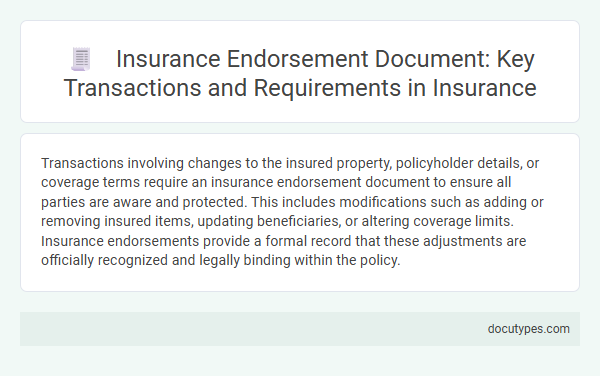Transactions involving changes to the insured property, policyholder details, or coverage terms require an insurance endorsement document to ensure all parties are aware and protected. This includes modifications such as adding or removing insured items, updating beneficiaries, or altering coverage limits. Insurance endorsements provide a formal record that these adjustments are officially recognized and legally binding within the policy.
Understanding Insurance Endorsement Documents
What types of transactions require an insurance endorsement document? Insurance endorsement documents are necessary when changes to an existing insurance policy affect coverage terms, such as adding a new insured party or modifying policy limits. These documents ensure that all parties have a clear understanding of updated coverage details.
Types of Insurance Endorsements
| Types of Transactions | Required Insurance Endorsement Document | Purpose |
|---|---|---|
| Adding or Removing Insured Parties | Named Insured Endorsement | Confirms authorized individuals or organizations covered by the policy |
| Changing Coverage Limits | Limit of Liability Endorsement | Adjusts the maximum amount payable under the policy |
| Altering Policy Terms or Conditions | Policy Condition Endorsement | Modifies or adds specific terms to the existing insurance contract |
| Adding New Coverage Types | Additional Coverage Endorsement | Extends protection to new risks or property not previously insured |
| Changing Property or Vehicle Details | Schedule Endorsement | Updates details like location, description, or vehicle identification |
| Transferring Ownership or Interest | Assignment Endorsement | Allows transfer of insurance benefits due to sale or other changes |
Your insurance transactions may require one or more of these endorsements to ensure coverage aligns accurately with the updated information or coverage needs.
Key Transactions Involving Policy Endorsements
Insurance endorsements are essential for transactions that modify the terms or coverage of an existing insurance policy. Key transactions requiring an insurance endorsement document include changes in policy limits, adding or removing insured parties, and updating coverage types. You must secure an endorsement to ensure that any alterations are officially recognized and legally binding within your insurance contract.
Legal Requirements for Endorsement Execution
Insurance endorsement documents are legally required for specific transactions to modify the terms of an existing policy. These endorsements ensure that changes comply with legal standards and protect all parties involved.
Understanding when an endorsement is necessary helps you avoid legal complications and ensures your coverage remains valid.
- Property Transfers - Endorsements are legally required when ownership of insured property changes, updating the policyholder information accordingly.
- Coverage Changes - Any modification to policy coverage, limits, or terms mandates a formal endorsement to be legally valid.
- Mortgagee or Lienholder Additions - Adding or changing a mortgagee or lienholder on a policy requires an endorsement document to satisfy legal and contractual obligations.
Steps to Request an Insurance Endorsement
Insurance endorsement documents are required for transactions that modify the original policy, such as adding new coverage, changing policyholders, or adjusting coverage limits. These endorsements ensure that all changes are officially recorded and legally binding.
To request an insurance endorsement, first contact your insurance agent or company with details of the required changes. Next, submit any necessary documentation and complete the endorsement request form provided by the insurer.
Common Documentation Needed for Endorsements
Insurance endorsements modify the original terms of a policy to reflect changes in coverage or conditions. These transactions require specific documentation to ensure accurate updates and legal compliance.
- Adding or Removing Coverage - Documentation such as a formal request or application is necessary to validate the change in insured risks or benefits.
- Changing Policy Limits - Proof of new valuations or underwriting approvals is required to adjust liability or coverage amounts correctly.
- Alterations in Named Insured - Legal documents like ownership transfer papers or partnership agreements must be submitted to update policyholder information.
Endorsement Approval and Processing Guidelines
Insurance endorsement documents are essential for modifying the terms of an existing insurance policy. These documents require careful endorsement approval and processing to ensure accuracy and compliance.
- Policy Changes - Any alterations to coverage limits, insured parties, or policy terms necessitate an endorsement document.
- Transaction Approvals - Endorsements must be reviewed and authorized by underwriting or claims departments to validate changes.
- Processing Timelines - Timely processing of endorsements ensures that your updated policy reflects the correct coverage without lapses.
Following these endorsement approval and processing guidelines protects your insurance interests and maintains policy integrity.
Impact of Endorsements on Policy Coverage
Insurance endorsements adjust or clarify coverage terms after a policy is issued. Common transactions requiring endorsements include adding a new vehicle, changing a property address, or updating beneficiary information.
Endorsements impact policy coverage by modifying risks, limits, or deductibles without issuing a new policy. They ensure Your insurance accurately reflects current circumstances, preventing coverage gaps. Understanding these changes helps maintain appropriate protection and avoid disputes during claims.
Recordkeeping and Compliance for Endorsements
Insurance endorsement documents are required for transactions that modify the original policy, such as coverage changes, adding or removing insured parties, and updating policy limits. These endorsements must be meticulously recorded to ensure accurate policy management and compliance with regulatory standards. Maintaining detailed records of endorsements supports audit readiness and verifies that all policy modifications are authorized and documented properly.
What Types of Transactions Require an Insurance Endorsement Document? Infographic

